What we can learn from Maya about water management
The Maya civilization (A.D. 250 – 1600s) ingeniously maintained their water supply in good shape for over a millennium, enjoying clean water without the need for chemical treatment. The method they had employed offers insights into addressing the impending water shortages modern humans suffer throughout the world.
Researcher Lisa Lucero of the University of Illinois in Urbana-Campaign highlights in a study published last October in the journal Proceedings of the National Academy of Sciences that the Maya's adeptness at ensuring clean water access through sophisticated reservoir management is very much akin to modern constructed wetlands, which utilize natural processes for water purification.

Lisa Lucero is a professor of archeology and anthropology. Credit: University of Illinois
Located in Mesoamerica (southeastern Mexico, all of Guatemala and Belize, and western portions of Honduras and El Salvador), the Maya Kingdom faced a prolonged dry season annually, causing river levels to drop and water quality to deteriorate. To counter seasonal scarcity, the Maya engineered reservoirs and connected them with cities via aqueducts, sustaining their civilization for centuries.
More to read:
Ancient Mesopotamians created the world’s first animal hybrids 4,500 years ago
The filtering relied on physical and biological processes for more than 1,000 years, keeping people hydrated and crops irrigated in times of droughts and scarcity, Lucero said in her paper.
Among the largest was the reservoir supplying the city of Tikal. It could hold over 900,000 cubic meters of water, well enough for the daily needs of its 80,000 inhabitants including drinking, washing, and cooking. These reservoirs featured linings from volcanic zeolite sand, imported from 30 kilometers (18 miles) away, which filtered impurities. Aquatic plants like cattails, rushes, reeds, and hyacinths removed nutrients such as nitrogen and phosphorus, preventing water stagnation and algae growth.

A network of Maya-built reservoirs as illustrated by modern researchers.
The Maya particularly worshiped the water lilies, which was associated with purity and royalty – depicting this flower along kings on monumental architecture and murals. To promote water lily growth, the Maya lined reservoirs with clay, providing shade and habitats for beneficial organisms. Harvesting fish waste and dead plants further enriched agricultural lands as nutrients.
More to read:
[animation] Ancient Greeks were first to build a railway
Lucero suggests emulating Maya techniques through artificially-established wetlands, aligning with the United Nations Sustainable Development Goal 6 for universal clean water access. These wetlands, self-sufficient once constructed, offer a sustainable alternative in times of severe droughts.
One solution as proposed by Lucero is repurposing existing resources, such as converting swimming pools into wetlands, to mitigate future water crises. By adopting such strategies, societies may safeguard against the pitfalls experienced by ancient civilizations like the Maya.
Such water systems, Lucera stressed, offer advantages over conventional wastewater treatment systems, due to low costs, high energy-saving treatment technology and clean water that supports aquatic animals and agriculture.
***
NewsCafe relies in its reporting on research papers that need to be cracked down to average understanding. Some even need to be paid for. Help us pay for science reports to get more interesting stories. Use PayPal: office[at]rudeana.com or paypal.me/newscafeeu.







